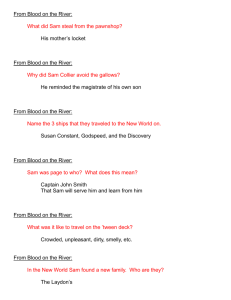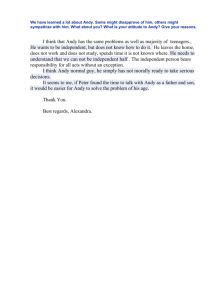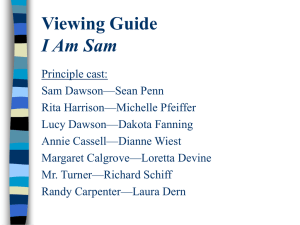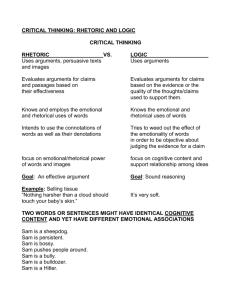Group Processes and Team Building Case Study: Robotics
advertisement
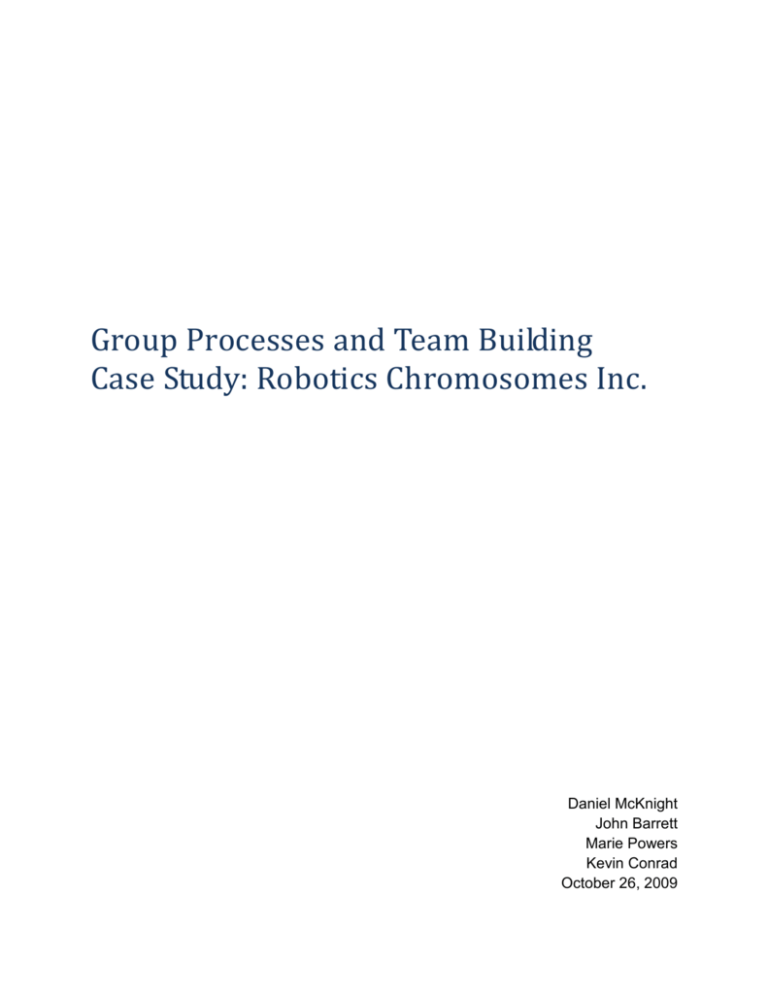
Group Processes and Team Building Case Study: Robotics Chromosomes Inc. Daniel McKnight John Barrett Marie Powers Kevin Conrad October 26, 2009 Overview of the company In case study number two; Robotic Chromosomes Inc. was studied by Sam. Over a period of several months he discovered many interesting facts about the company. At the conclusion of his time with the company, Sam reported back to Group Three. Group Three was responsible for translating his finding and solutions. A detailed report on what he did to fix the problems were established accordingly. The Robotics Chromosomes Inc. was founded by Andy, a graduate of Stanford University. He formed a small company in the bio-informatics market, which fashioned several software products to help biologists, scientists, and laboratories. His team consisted of colleagues of his from Stanford, and whom he considered close friends. His office building has a large open-spaced floor plan with nicely divided sections for each team. Andy and the other Vice Presidents had corner offices, with great views. There are seventy-five happy employees that work under Andy’s control of the rapidly growing company. Starting in 2000, after the first three very prosperous years, Andy received numerous offers to buy out his company for a fairly decent price. R.C was the first company to establish itself in the visualization field. Andy denied every offer that was put on the table. As the company was finally progressing to a comfortable, well-developed business they hit their peak and things started to go downhill. After many years of expanding and being very popular, the company could not keep up with the demands. “The lack in the Quality Assurance department and their loose bug tracking metrics were becoming costly.” The Players Throughout this case study, people were recognized and immediately tagged as needing improvement in several different departments. In each team there were people who stuck with each other and relayed to one another, as well as members that would disagree with each other. In each team, members would form a hierarchy within a hierarchy at a company. A common hierarchy consists of a president, CFO, team’s leaders of each department and the workers that do the actual work. As commands for tasks were given by upper management, they are relayed back and forth between the heads of the department, who manage their crew to get the task completed. TOM- At the beginning, Andy hired a very talented and reputable engineer who, although very smart, had quirky habits. While interacting with people in the office, he found that Tom is an avid martial artist. If someone brushes up against him, he spins around, with a raised fist ready to fight. He was known for showing up no earlier than 11 A.M. but worked late into the evening. BOB- As the company grew Andy hired Bob, a statistician. He is a Stanford Alum and very good friend of Andy; they play weekly group board games. Andy hired Bob to help with the analysis tools of the Chromo Rivers Software Program, a very much needed specialty in this field. MIKE- As the company kept growing Andy hired Mike as the Chief Financial Officer (CFO). Mike was hired mainly to help accelerate the company‘s growth by using tactics such as fundraising. The Robotics’ Company started experiencing unavoidable bug problems after Mike was hired. There growth has been slowed and they are feeling the impact of not being able to fix the bugs and loosing numerous return customers. Andy hired Sam who is an experienced veteran of the software industry to put together a Quality engineering department. Sam's Findings The Problem: After the company’s slowed growth and high problems with bugs in the system, Andy hired a professional, Sam, who knows software systems. Sam discovered: -There was confusion and no recognized bug tracking systems; therefore all reported bugs were maintained by one person in an MS program. -The engineers and tech support departments were constantly arguing over what was and was not fixed for possible bugs in the system. - Six hour meetings were held every Wednesday. Most of the meeting was spent going over problems from last week’s meeting. - Product Documentation, which was run by Chris, a female worker, complained that no one told her what would be in each release and left her with only a few hours until it had to be posted on the internet. The features and updates were too intricate to be completed in such a short time. She needed more time. - Chris and Bob, along with many others, complained about not being paid enough for their positions. When Andy hired people, he gave the lowest pay, but in return gave the new hires stock options to make up for it. - When Sam investigated, he found over two dozen bugs in the system. He went to Mike looking for a budget as a way of knowing how much he could put into fixing the bugs. However, Mike refused to give Sam a budget. The problem was that Mike did not agree with Andy’s decision to hire Sam and thought it was an unnecessary expense. Sam’s Solution: In studying and evaluating the employees and groups at Robotic Chromosomes Inc., Sam had developed a highly functional team that met and discussed the problems that he found within the company. He then executed the solutions he deemed appropriate for fixing the problems. Each engineer was asked to identify who would be responsible for each feature and then document his or her own work. After months of progress, Sam appointed a new process to each manager on fixing the bugs for long term Quality Assurance. Some went along with his advice, while others like Paul, refused to fix the problem. Sam’s new bugging system did improve the company but only through tough decisions. Where the problem starts… Paul believed that the new debugging system did not apply to him, while other members of the engineering team told Sam that Paul was not sure how to use the new system, instead of trying to figure it out. He just had the bugs redirected to a younger member of the team. Meanwhile, Sam had put a female employee, Chris on probation for 30 days for failing after receiving a warning because she was not meeting expectations. Her warnings were discussed in meetings that outlined her goals. However, at the end of her 30 day probation period she was fired because she did not meet her goals. Since Sam hired Chris, Mike blamed Sam for a bad hiring decision which costs the company an unnecessary expense. Another problem that Sam encountered was on a new release. Tom’s features were not completed and instead added more bugs to the system that threatened Chromo River’s product as a whole. When Sam talked to Tom, Tom said that he had more important things to do and that customers were the least of his concerns, calling customers a bunch of idiots. Sam fixed Tom's mistake in about fifteen minutes while Andy backed Tom’s actions. After Sam left the company … After 9/11, the company went through a severe crash and Sam and many others got laid off right before Thanksgiving. The Company went back to its old ways and a week later released products without testing them; sales went back up. Months later Andy was forced to fire Tim, one of the V.P.’s for secretly running a competing company and failing to close sales at Chromo River. Bob left shortly after due to Andy not giving him a raise in the course of two years. Andy’s only response was that “this is a terrible economy, and you have nowhere to go. I’m not going to give you a raise.” And after a couple months Bob found a new job that paid him considerably more money. If Andy had only gave some indication that he valued Bob as a person he would have stayed. Now the company is without a statistician and for the past six months, the very much needed math has been done almost completely wrong. Eventually they hired a new guy at a low salary who took three months to come up to speed. Group Dynamics Project Proposal September 23, 2009 Professor Balzac: The case study; Assignment number 2 was reviewed by group three for the Robotic Chromosomes Company. After a detailed analysis from Sam, some of the noted problems and questions that arouse were the following: - How were the apparent stages of the group developed at R.C.? - What were some of the Manifested values and Beliefs of the group? - What were the apparent communication styles or patterns? The role of emotions in the group: which emotions are playing out? How are autonomy, competence and relatedness manifesting between the group as a whole and different sub groups of people? Why was there resistance to changes that appeared to address issues that people were claiming they wanted change or fixed? - Which avoidant behaviors are manifested and what might that mean? - If you were in Sam’s position, what would you have done differently? - What recommendations do you have for the company? - Present you recommendations in a way that a CEO might accept? Discussion Questions As we discussed further into the situation, we came to the agreement that Robotic Chromosomes Inc. needed further help towards a goal that was not met. The goal that was not met was providing consumers with a quality product that could be used effectively. Throughout the time that Sam was a part of group three, development was apparent. In the beginning, everyone and everything revolved around Andy and his decisions. He was the founder and owner of the company and it was up to him to make forward movement in the company. At least, this is how things seemed. At times people disagreed with Andy yet he still stood in charge. We believe that at R.C they were a decentralized company in which everyone wheeled around Andy. Meaning that if there was a problem, all information was given directly to the president and he then was expected to make sure it was controlled. No one took any initiative to take it upon themselves to control the situation. When Andy brought in Sam, the group changed its wheel shape and formed a Y-Pattern, where Andy and Sam fought for control over the department. If someone didn’t like Sam's decision they went to Andy and vice versa. People like Mike who didn’t like Andy’s decision and refused to help Sam in any way followed the stem of the Y and all information would have to be indirectly brought up or given to someone by a middle man. Everybody wanted change but not everybody wanted to make the changes needed to try a new procedure. This meant that even though Andy hired Sam it didn’t mean that people were going to develop into a model image company that Sam wanted it to be over night. Sam was only a basis to try and give new ideas about how to make an old system better. The process was dull and such as a knife cutting into a thick piece of meat, was making more of a mess than actually cutting. Instead of Sam making clean cuts he was really just messing the entire system up. People that Andy hired were all people he knew in some fashion or another. He knew Mike socially from game night and Bob, whom he met through college. All were hired on the basis that they had good social relations. Andy hired each employee for as little pay as possible, but offered stock options as a way to make up for the lesser pay. The manifested values and beliefs at R.C are to accomplish as much work at the cheapest pay possible, and just getting the program to run and out to the public. People like Tom, who just didn’t want change, resisted the fact that the company needed an overhaul to help manage a bug free system and to produce quality products. All short and long term goals were lost and team succession was few and far between. Employees were not taking the initiative to help out the next link in the chain of command. The idea was to get the work done, hand it off to the next person in line let it become their problem to deal with. As in the example; all the program files that the engineers created go to Chris in the Documentation Department. Here she edits, formats, and updates all the new features that need to be released to the customer on a strict deadline. Almost every time she had little documentation, but barely any time to process the information correctly and still get it out on time. This situation is also apparent in their communication skills. None of the engineers talked to Tech Support to see if the bugs in the system were corrected or not. Due to this, many issues went by the wayside because no one felt like dealing with it. If there was a problem and someone did speak up, it usually went to either Sam or Andy. Instead of talking to the person who it affected directly and taking care of it before it went any further, it was talked about behind that person's back. Nothing ever gets solved long term; only long enough to get a defected product out to the market, hoping it does not have too many bugs and the client buys it. This is where the issues of avoidant behaviors come in. People who avoid obvious problems in a situation, avoid them because they do not want to be held responsible for making the changes, nor do they want to admit a setback in the new technology. By not taking responsibility for the bugs, the people who knew about them and did not say anything are assuming responsibility for being negligent of a product. This is worse than taking responsibility from the get go. We feel that in order for the company to run smoothly, employees should not avoid problems as they come up. Nothing really seemed to be working smoothly at R.C. with the new policies in place. People that were a part of the Engineering Department were the least likely to conform to the new rules. Tom and Paul, who were part of the older aged workforce, still firmly believed in that process. They were not willing to change to a new process that may be better for the company. The newer members of the engineering team were willing to make a change in their routine and were more willing to listen to Sam’s suggestions. After Sam left the company, it did not take long before people at R.C went back to their former ways of doing business. Bugs in the system were not solved and mainly left alone do to time constraints and lack of caring. Paperwork was still a disaster when given to Chris, and the biggest problem was that people were just plain unhappy in their working environment. We think that to the people it seemed as if there was no direction and Andy was not concerning himself and being more involved in what each member was working on. Since we are not in Sam’s shoes, we only know from what was provided for us in the outline about what actually went on at R.C. Group three agreed on the fact that there would be some things that needed to be done differently. What comes to mind first is how Sam approached new members of the company. He found very interesting and necessary finds to make changes to R.C. However, not once did Sam sit with Andy and build a work relationship with him or anyone else. It seemed that Sam did his findings and told people to do what he said. Instead of going along with the same thought, we have made a customized plan of action for each member at R.C. In the area of long term goals, this would be more successful because people would feel that they were special in some way and someone cared enough to take the time to teach them. A statement from Bob, the statistician said “If he’d just given me some indication that he valued me as a person, I would have stayed.” Another situation we would have handled differently throughout the entire case study at R.C would be to have conformed as to how R.C did business and not how Sam wanted it to be done. Sam would have had more people following him than fighting him if he had attempted to not drastically change the system. Andy and his team were a group of very intelligent people, who had a process of doing office work very differently. Sam came in trying to create a standard system and smooth transitions between departments. Such things as setting goals for the team and for personal improvement, time based projects handed in on time, taking the time to ask for help on projects, scheduled meeting to be on topic and no rehashing previous problems, and finally being able to confront each other if a problem arose and handling it in a professional manner. MEMORANDUM TO: ANDY (CEO), AND ALL R.C PERSONAL FROM: DANIEL MCKNIGHT, JOHN BARRETT, MARIE POWERS, KEVIN CONRAD SUBJECT: RECONMENDATIONS FOR FUTURE @ R.C. DATE: 3/8/2016 CC: PROFESSOR BALZAC To Andy (CEO) of Robotic Chromosomes Inc.: Group three has reviewed and studied case study two. We were presented with detailed facts and findings from Sam, who spent a period of time developing a new process for R.C. Sam implemented such suggestions as background research on company personal, locating and tracking forgotten algorithms, and finding over two dozen probable bugs in the Chromo River system. Under Sam’s direction most things were not accomplished from what he wanted to have changed. Both parties were unsuccessful at managing positive improvement. Most importantly, the people at Robotic Chromosomes needs were not met. Therefore group three will be providing Robotic Chromosomes Inc. with Recommendations to help further the development and success of producing several different software automation tools used in various fields. Please consider the following suggestions: - Maintain real expectations - Resolve all issues directly and professionally. - Respect others decision - Do not be afraid to ask for help - Make Quality Products for your consumer, they are what keep you in business - Be open to new ideas, and no idea should get left unnoticed - Take the initiative to communicate in and outside your department. - People should not be limited to their job title but to be dispensable when another departments need the extra help with work (NOTE: These recommendations are to be used as guidelines only, and are intended solely for the use of Robotic Chromo Rivers Inc.



